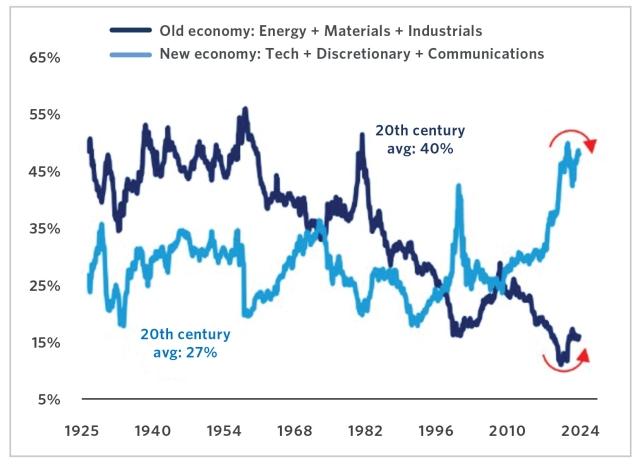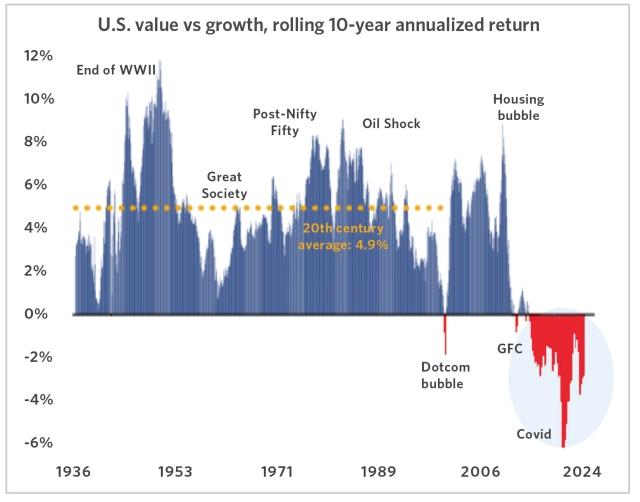In this article we review:
- How technological innovations have helped redefine the large-cap value market
- How to build a modern large-cap value portfolio
- The attractive relative valuation of large-cap value stocks
The realm of large-cap value investing has undergone significant transformations over the past few decades. This article explores the historical context of large-cap value investing, the impact of technological innovation, and modern approaches to constructing balanced portfolios.
Historical Context and Evolution
Historically, investors looked to large-cap value stocks to add an element of stability and income to their portfolios, often by investing in well-established companies with good reputations. These companies were not typically expected to deliver high growth but instead offered reliable returns and consistent dividend payments.
Today, the large-cap value landscape looks much different, as there have been meaningful shifts in the drivers of economic growth and the sector exposures to those drivers. As such, while the large-cap value universe still includes mature, stable companies, it also now includes the ability to invest in many of the secular growth themes that are driving the markets today.
Technological Innovation
Looking at the S&P 500® Index (and precursor since 1925), the old economy, generally defined as the energy, materials, and industrials sectors, accounted for over 50% of the market cap of the index. It reached its peak in the late 1950s. As of Q1 2024, the old economy only accounted for about 15% of the index. Meanwhile the new economy, generally defined as technology, consumer discretionary, and communications, which made up about 25% of the S&P 500 Index market cap in 1925, made up close to 50% of the index as of Q1 2024.
This reversal in leadership, which meaningfully accelerated with the dot-com internet boom of the mid-1990s, has continued through today, with technology companies driving much of the innovation we see in the modern economy. More broadly, sectors that were once at risk of stagnation, such as industrials, are now leveraging technology to improve efficiency and develop new products. Elsewhere, in energy, we see renewables replacing carbon as a fuel source. In financials, electronic payments are replacing cash. Within media, digital advertising is replacing legacy mediums (print, T.V., radio, etc.). And in healthcare, we are seeing huge advances in personalized medicines and telehealth capabilities.
Technology has also reshaped the retail landscape. It has changed the way we educate. And it has changed our ability to communicate and disseminate information around the globe.
These are just a few examples of changes we believe can create opportunities for scale players. And as these rapid shifts blur the lines between traditional value and growth sectors, we believe investors need to adopt a more dynamic approach.
Source: BofA Research Investment Committee, Global Financial Data, Bloomberg
The Current State of Large-Cap Value
The large-cap value space now offers the opportunity to invest in many of the major secular investment themes driving the markets, such as global electrification and de-carbonization, manufacturing onshoring and supply-chain security, and artificial intelligence (AI), but with more valuation discipline than one might find on the growth end of the spectrum.
In addition, over the past few years, corporate profit and cash flow trends have remained more resilient than anticipated, favoring stocks in the traditional value sectors such as energy, materials, consumer staples, healthcare, utilities, and specific areas of financial services. The combination of these factors has allowed companies in the value sector to reinvest in their business to gain market share and extend their competitive advantages. The costs to compete are ever-increasing, disadvantaging smaller players.
Constructing a Modern Portfolio
Building a modern large-cap value portfolio involves balancing traditional value investing principles with the need to adapt to contemporary market dynamics. This balance is achieved by minimizing factor and sector bets, which ensures that stock selection remains the primary driver of returns. It also requires closely monitoring portfolio characteristics relative to the benchmark, such as the Russell 1000® Value Index, especially during the annual benchmark reconstitution.
In terms of stock selection, by focusing on companies with robust business models, the ability to generate cash flow beyond internal needs, and clear growth catalysts, all while maintaining valuation discipline, investors can create portfolios that perform well across different market environments.
We believe a relative-value investment approach provides the opportunity to perform well across most parts of the market cycle. Within this framework, we think it’s important to have a portfolio anchored by profitable, attractively valued, growth-oriented companies and balanced by more cyclical, discounted stocks.
And finally, the valuation gap between growth and value stocks has widened in 2023-2024, with the Russell 1000® Value sitting near a 30-year low versus the Russell 1000® Growth Index, providing an attractive entry point for value-oriented stocks, in our view.
Russell 1000 Value Relative to Russell 1000 Growth is at Historic Lows
Source: BofA Research Investment Committee, Fama French value and growth indices
Conclusion
The landscape of large-cap value investing is continually evolving. Investors must stay informed about these changes and adapt their strategies accordingly. By integrating modern analytical tools, focusing on innovation, and maintaining balanced portfolios, investors can uncover hidden opportunities. Embracing a dynamic approach to value investing will enable investors to navigate the complexities of the market and achieve long-term success for their clients.
About the Authors
Paul Roukis is a Portfolio Manager on the Great Lakes Advisors Fundamental Equity Large Cap Value and Focused Large Cap Value strategies. Paul joined Rothschild & Co Asset Management US in 2005 and has been in the industry since 1992. Previously, Paul was a research analyst for more than 12 years with Sidoti & Company, Schroders, NatWest Securities, and Value Line. Paul earned a BBA from Hofstra University and is a CFA® charterholder.
Jeff Agne is a Portfolio Manager on the Great Lakes Advisors Fundamental Equity Large Cap Value and Focused Large Cap Value strategies. Jeff joined Rothschild & Co Asset Management US in 2015 and has been in the industry since 2001. Previously, he served as a co-portfolio manager for the Global Focus strategy at PineBridge Investments. He was also an Equity Research Analyst at Banc of America Securities and Schwab Soundview Capital Markets, and a Consultant for FactSet Research Systems. Jeff earned a B.S. from the University of Vermont and an MBA from New York University's Stern School of Business.
Related Funds
Index Definitions
The Russell 1000® Growth Index measures the performance of those Russell 1000 companies with higher price-to-book ratios and higher forecasted growth values.
The Russell 1000® Value Index measures the performance of the large-cap value segment of the U.S. equity universe. It includes those Russell 1000 companies with relatively lower price-to-book ratios, lower I/B/E/S forecast medium term (2-year) growth and lower sales per share historical growth (5 years).
The S&P 500® Index is a widely regarded gauge of large-cap U.S. equities. The index includes 500 leading companies and covers approximately 80% of available market capitalization.
Past performance is not indicative of future results. It is not possible to invest directly in an index, which also does not include the application of fees.
Important Information
All opinions, estimates, projections, and security selections contained herein are those of the sub-adviser. It does not constitute investment advice and should not be used as a basis for any investment decision.
Mutual funds are subject to market risk, including loss of principal. Past performance is not indicative of future results.
Mutual funds are sold by prospectus. Before investing, consider the funds' investment objectives, risks, charges, and expenses. This and other important information is contained in the prospectus. Please visit transamerica.com or contact your financial professional to obtain a prospectus or, if available, a summary prospectus containing this information. Please read it carefully before investing.
The price of equity securities fluctuates based on changes in a company’s financial condition and overall market and economic conditions. If the market prices of the equity securities owned by the fund fall, the value of the fund will decline. Value approach carries the risk that the market will not recognize a security’s intrinsic value for a long time or that an undervalued stock is actually appropriately priced. The fund may be more concentrated than that of a more diversified fund, subjecting it to greater fluctuation and risk.
Transamerica Funds are advised by Transamerica Asset Management, Inc. (TAM) and distributed by Transamerica Capital, Inc. (TCI), member of FINRA.
Transamerica Companies and Great Lakes Advisors LLC are not affiliated companies.
Note: Rothschild & Co Asset Management US was acquired by Great Lakes Advisors LLC on April 3, 2023.
1801 California St., Suite 5200, Denver, CO 80202





